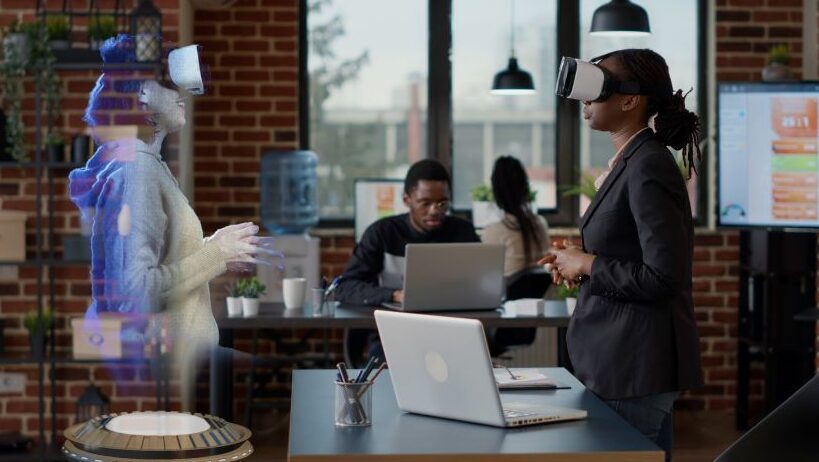Virtual Reality And The Modern Learner
The use of Virtual Reality (VR) in training has revolutionized the learning process for modern learners. It enables employees to develop and improve their skills of communication, collaboration, leadership, and creativity. In today's fast-changing workplace, VR provides a safe and immersive environment for learning new tasks and tackling challenging or risky scenarios. Embracing Virtual Reality in training empowers learners to thrive in today's dynamic workplace and helps them stay ahead in an ever-evolving world.
The bigger question, however, is: Is your organization ready to embrace VR? The following are areas to consider when planning to implement VR.
Organizational Readiness And Virtual Reality
Virtual Reality is an immersive technology that has revolutionized training but requires careful consideration. Before adopting VR for training, here are the key steps to help you create a plan for implementing VR:
- Time and resources – VR training takes longer to develop than traditional methods of training. Assess your timeline and scope realistically. If you have limited resources, consider outsourcing or using existing VR solutions.
- Budget and ROI – VR training provides innovative approaches to learning. Consider the initial costs due to hardware and maintenance. Analyze the budget and ROI compared to other options, including ongoing content updates. ROI can be measured more quickly with VR as opposed to traditional training methods.
- Workforce familiarity – Provide support towards your team's VR literacy and comfort with the technology.
- Industry alignment – Research how your industry uses Virtual Reality in training and learn from others' experiences.
- Topic suitability – Evaluate whether VR aligns with your training objectives. VR training can be more suitable for some topics than others, depending on the learning objectives and outcomes. You should evaluate how VR can add value to your training topic. Ask whether VR's capabilities can address the topic objectively and how it can support the cognitive, effective, and psychomotor domains of learning.
- Metrics and evaluation – Determine the metrics you want to measure and ensure you have the tools and skills to analyze the VR data.
- Integration with existing training – Explore how VR can complement or supplement your current training methods.
By addressing these questions, you can determine your organization's readiness and make informed decisions to harness the full potential of VR for your training needs.
Benefits Of Virtual Reality In Learning
The use of VR in training saves time and money while also delivering improved learning outcomes. It allows learners to experience immersive and interactive simulations of real or imagined environments. VR has many other benefits in the context of learning, such as:
- VR can increase engagement and motivation by providing learners with a sense of presence and agency in the virtual world.
- It can enhance retention and recall by creating memorable and emotional experiences that activate multiple senses and different regions of the brain.
- The technology facilitates experiential and situational learning by enabling learners to practice skills and apply knowledge in realistic and relevant contexts.
- Its usage can foster collaboration and communication by allowing learners to interact with their peers, instructors, or virtual characters in the same or different locations.
- VR can support personalized and adaptive learning by offering learners choices, feedback, and guidance based on their preferences, performance, and progress.
These are only some of the benefits of VR in learning. VR is a powerful and promising tool that can transform education and learning in the 21st century.
How To Implement Virtual Reality
The successful usage of Virtual Reality in training requires careful planning, execution, and evaluation. Keep sessions short, limit exercises to 20 minutes, and encourage breaks to prevent virtual fatigue. Ensure access to suitable hardware and provide training exercises and user guides to boost confidence. Perform comprehensive risk assessments for employee safety.
Additionally, VR's data collection capabilities offer insights that can be used to optimize the training. A well-planned VR training approach can revolutionize learning by enhancing learners' skills and overall performance. Leveraging VR's immersive power creates a more efficient and impactful training landscape, contributing to long-term growth and success.
Real-World Applications Of VR In Learning
VR is effective for a broad range of learning scenarios across workplaces. Here are some real-world workforce applications of VR in learning:
- High-complexity learning – VR is ideal for high-complexity training, providing scenarios that are nearly impossible to recreate in the real world. For instance, training astronauts would be costly and challenging in the real world but is a suitable match for VR execution.
- Institutional knowledge transfer – VR facilitates institutional knowledge transfer by capturing the expertise of retiring workers. Companies can preserve valuable knowledge and even use VR to teach customers how to use products effectively.
- Healthcare – One of the most promising use cases of high-risk training is in the healthcare industry, where learners are exposed to potentially dangerous situations. For example, doctors can learn complex surgeries without endangering patients.
- Manufacturing and automotive – Given the complexity of manufacturing environments today, even slight errors in worker judgment might have serious repercussions, including brand destruction, loss of client confidence, and financial impact, such as mass recalls of automobiles. VR can train factory workers, automotive assembly-line workers, and manufactured component installers and equip them with the industry's best practices.
- Aviation – Given the high stakes involved in air travel, VR is proving itself as an able training aid in the aviation industry. For example, pilots can practice flying in flight simulations, perfecting their skills in real life-like situations. Service staff, on-ground and in-flight, also learn and practice working in VR-simulated, high-stress, customer-centric situations.
- Soft skills training – VR also proves itself valuable for soft skills training, as it simulates real-life scenarios with facial expressions and body language. Employees can practice and develop skills, like active listening, conflict resolution, and negotiation, in a safe and realistic virtual environment. The use of VR in soft skills training can foster enhanced empathy among employees by exposing them to unique, immersive scenarios that would otherwise remain beyond their reach.
- Safety training – Workplace accidents cost lives and reputational damage. Professional tradespeople, like utility workers, can train safely with VR to acquire the necessary skills to prevent accidents and improve safety records.
Insights On How To Create A Business Case For Virtual Reality
Before implementing VR training in the workplace, develop a comprehensive business case that outlines the potential benefits and considerations. A well-structured business case helps assess the feasibility and impact of adopting VR for training purposes. This analysis includes evaluating performance improvements, investment costs, cost savings, and critical considerations for successful virtual adoption.
1. Performance Improvements
VR training offers a highly immersive and interactive learning experience, leading to enhanced engagement and knowledge retention among employees. It enables learners to apply their skills in a risk-free environment, resulting in improved performance and competency.
2. Investment Costs
While there is an initial cost to implement VR training, the long-term benefits far outweigh them. Properly assessing the investment costs helps organizations understand VR's role in employee development, increased productivity, and organizational growth.
3. Cost Savings
VR training presents cost-saving opportunities by eliminating travel expenses and reducing administrative time. Additionally, the absence of repeat trainer fees—as employees can revisit trainings as and when needed—contributes to a further reduction of costs.
4. Considerations For Virtual Adoption
Implementing VR training requires the careful consideration of various factors, such as the availability of suitable hardware and providing adequate training to increase employees' confidence in using the technology. Conduct a thorough risk assessment first to ensure safe training, and address potential challenges associated with VR adoption.
The business case for VR training is the foundation for successfully implementing VR and securing support from key stakeholders. By showcasing performance improvements, cost savings, and org-wide productivity gains, organizations can make informed decisions that lead to a transformative and effective Learning and Development experience for their employees.
Costs Of Implementing Virtual Reality In Learning
Introducing VR training offers cost-effective solutions for businesses, but comes with upfront—sometimes significant—investments. Key costs include:
- Hardware – Devices like HTC VIVE and Oculus Quest. Falling unit prices of hardware make it more viable to integrate VR into learning today.
- Software – Software expenses vary based on sophistication, with platforms like Future Visual's VISIONxR™ offering options to suit budgets.
- Ongoing costs – Additional ongoing costs include annual platform fees, user licenses, and integration with HR systems.
- Course-related costs – Course planning and content development demand resources to define objectives, structures, and the learning content. It also requires ongoing costs for updates and relevance.
Despite the initial investment, well-executed VR training brings efficiency gains and improved learning outcomes. Businesses must carefully assess costs to make informed decisions on adopting VR training programs.
Virtual Reality And Learning Effectiveness
VR training is highly effective and offers advantages over in-person or online learning. Consider these results from a study performed by the consulting firm PwC:
- 40% of virtual learners reported an increase in confidence compared to classroom learners. Moreover, 35% of them showed an improvement in being able to apply what they learned after undergoing training in a VR environment.
- When it comes to large-scale learning, VR learning is the most cost-effective method. With 375 learners, VR training achieved cost parity with classroom learning. With 1950 learners, VR training achieved cost parity with eLearning. And with 3000 learners, VR costs become 52% less than classroom learning.
- VR helped learners complete the training 4 times faster than in-class training, and they were 4 times more focused than eLearners—and 1.5 times more so than their in-class peers.
- VR learners felt 3.75 times more emotionally connected to the content than classroom learners and 2.3 times more connected than eLearners.
VR's cost-effective scalability allows the training to be rolled out to multiple locations without live trainers, which leads to a 50% reduction in costs compared to traditional methods.
For soft skills and procedural training, VR fosters a deep emotional connection, resulting in improved information recall with retention levels of up to 80% after a year. In hazardous industries, VR provides a relatively safer learning space for practice, and real-time data capture provides in-the-moment feedback and comprehensive impact analysis.
What's Next In Virtual Reality For Workforce Enablement
The AR and VR market is expected to reach $297 billion by 2024, driven by a growing acceptance. Virtual Reality will revolutionize industries, enable the workforce, and transform workplace and business-customer interactions. In retail, the use of Virtual Reality in training simulations will prepare employees for real-life scenarios. Education already benefits from VR's 20% training score improvement and remote learning experiences. VR advertising will thrive even more, with technological advancements captivating broader audiences.
High-quality stereoscopic videos and eye tracking are boosting VR experiences. Relatively cheaper hardware, like Oculus Go, is set to attract more consumers with their offering of immersive experiences at low prices. While gaming dominates the VR software market today, other aspects of L&D will see greater penetration by VR with the creation of innovative content.
Final Thoughts
VR and AR revolutionize learning and training, especially in today's AI/Machine Learning era. Integrating AI with VR/AR enhances content customization and the delivery of personalized experiences. The increasing use of Virtual Reality in trainings promises highly enabled workplaces, improved learning, and innovative productivity strategies. A future of enhanced employee experiences awaits.
Read More:
- The Impact Equation: A Practical Guide to Measure and Demonstrate Training Impact [eBook]
- How to Measure the Effectiveness and Impact of DEI Training
- How to Design and Develop Engaging Learning Programs Using Learning Technology
- Modernizing L&D – Technology Trends to Help Design, Develop, and Deliver Impactful Learning Programs
- AI in eLearning – How Natural Language Processing and Other AI-enabled Solutions Will Transform the Industry


